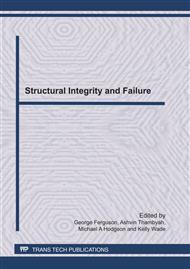p.214
p.218
p.222
p.229
p.234
p.239
p.243
p.247
p.251
The Influence of Processing Parameters on the Void Content and Compressive Strength of Carbon Fibre-Epoxy Laminates
Abstract:
This research addresses the influence of various processing parameters on the post cure quality of carbon fibre composites. Four processing parameters were investigated in the study, in terms of their impact on void content and overall compressive strength. The first parameter distinguishes between laminates cured in a vacuum oven and those cured in an autoclave under high positive pressure. The second parameter describes the impact on voids of differing fibre architectures, comparing a unidirectional fibre structure to that of woven cloth. Thirdly, the influence of compaction during manufacture is analysed and lastly, variation in cure temperature was tested to determine its effect on final laminate quality. The quality of the cured laminate samples was assessed from visual inspection, and in terms of compressive strength and void fraction calculated by Micro-CT X-ray Tomography. The results show that autoclave-cured samples feature significant quality improvements in terms of void fraction and compressive strength when compared to oven-cured samples. Unidirectional laminates incur higher sensitivity to void inclusion than cloth laminates due to the influence of fibre wrinkling. Compaction has no effect on laminate strength; it does however reduce variability in certain cases. Temperature affects different fibre structures in different ways, these being highly dependent on curing method. Finally, it was discerned that curing by autoclave was the dominant processing parameter. Thus, regardless of other manufacturing techniques, the autoclave samples featured almost zero voids and were consequently of the highest quality.
Info:
Periodical:
Pages:
243-246
Citation:
Online since:
July 2011
Authors:
Price:
Сopyright:
© 2011 Trans Tech Publications Ltd. All Rights Reserved
Share:
Citation:


